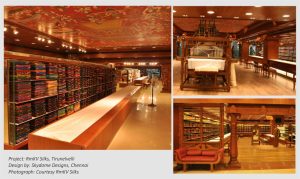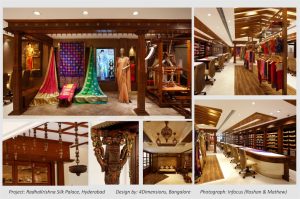The Indian sari can be traced back to the Indus Valley civilization and has gracefully stood the test of time without changing the way it’s worn. The five-to-nine yards long and two-to-four-feet-wide garment has been interpreted in over 30 types of regional weaves and 80 ways of draping! International celebrities like Paris Hilton, Naomi Campbell, Julia Roberts and Katherine Heigl – just to name a few – have glamorized the humble sari in the world of global fashion.
In modern India, the sari is not only a symbol of cultural pride but also a preserver of millions of craftsmen who weave exquisite designs from cotton, jute, silk, gold and silver fibers, inspired from culture, myths, symbols and imagination. The sari market, monopolized by traditional retailers, is half of the Indian ethic wear market, and is growing at a compounded annual growth rate of 9 percent, which is projected to reach $9.3 billion (USD) by 2019, according to an analysis conducted by Technopak (Gurgaon, India) of ethnic wear in India.
Most sari buying is a community ritual for families, often involving three generations participating in the decision making of one sari purchase for the youngest member. Typical sari buying involves browsing between 30 and 50 saris before deciding. Persuasive master salesmen, who effortlessly open and display 10 saris in the blink of an eye while explaining the weave and the pattern, play a critical role in the purchase.
Big-box regional sari stores display over 200,000 saris in about 25,000 square feet of retail space and are generally organized by materials, weaves, occasion, color and price points, ranging from 200 rupees ($3.50 USD) to 2,000,000 rupees ($30,000 USD)! Retail design plays a very important role in crafting aspirational environments that emote the love for culture and art while enhancing the sari shopping experience. A typical sari shopping journey consists of three types: assisted, semi-assisted and unassisted. Here’s my selection of inspirational sari stores that use retail design and presentation to keep generations of customers inspired and loyal.

Founded in 1924, RmKV Silks (T. Nagar, India) is reputed for its exquisite wedding silks, endorsed by two national awards in handloom silk weaving. The RmKV design studio has conceived many innovations like a reversible sari, a natural silk range and Lino light-silk sari collection. They also offer hand weaved, custom designed wedding saris that can be curated from a palette of over 50,000 colours. Its store design is inspired from traditional arts and crafts from south India. This is realized in columns carved by wood craftsmen, hand painted ceiling art and a traditional loom installation to create a boutique like environment in the 20,000-square-foot space. This complete service, assisted format store boasts a dominant range of more than 250,000 saris in silk, cotton, jute and artificial fibers, all served by an army of over 200 specialized sales assistants.
Advertisement

Radhakrishna Silk Palace (Andhra Pradesh, India), a relatively younger store brand, was founded in 1999 and is a super specialist in the traditional weaving art of the very famous Kancheepuram Saris (from the region by the same name in the southern state of Tamil Nadu). These saris are woven from pure mulberry silk thread derived from a tradition of master weavers who are believed to be descendants of Sage Markanda. The store, spread over 2500 square feet, is designed with inspirations from the history, architecture and temples of the city of Kancheepuram rendered in premium wood carved counters, decorative trellis patterns, temple ornaments and metal inlays. Paying tribute to the brand’s core tenet is a polished working wooden silk handloom supported with a digital display featuring “edutaining” films on the brand’s master weaving expertise. This semi-assisted format store presents its exclusive range over the counter and the casual range in self-service fixtures.

Taneira (Bengaluru, India), the new kid on the block from Tata’s Titan Company, has entered this domain monopolized by traditional retailers. The purpose of the brand is to celebrate the heritage of Indian handloom saris by empowering the handloom weaving industry and repositioning the sari as a progressive garment for the young Indian. The store presents the finest collection of 32 handwoven and handcrafted private label saris in an open, unassisted format that allows customers to touch and feel the purity of each fabric and its craftsmanship. A full-fledged customization “Style Studio” and a garden café enhance the experience. The store’s palette uses traditional Indian arts and crafts interpreted into a modern relaxed environment, punctuated with storytelling through visual merchandising.
With India being a country of many cultures and religions – celebrating more than 75 festivals in one year — it is a matter of cultural pride that the elegantly crafted sari will continue to remain in fashion, today and for all generations to come.
Surender has more than two decades of experience in the Indian retail industry in retail strategy, store design, planning and development, retail marketing, visual merchandising, writing and academia. He’s held senior positions at leading retailers like Shoppers Stop, Reliance Retail, Mahindra Retail and as a senior retail consultant working with leading retailers and brands in India. Reach him at surenderg.retail@gmail.com.
Advertisement


 Headlines1 week ago
Headlines1 week ago
 Photo Gallery19 hours ago
Photo Gallery19 hours ago
 Headlines2 weeks ago
Headlines2 weeks ago
 Headlines2 weeks ago
Headlines2 weeks ago
 Sector Spotlight1 week ago
Sector Spotlight1 week ago
 Headlines1 week ago
Headlines1 week ago
 Headlines2 weeks ago
Headlines2 weeks ago
 Headlines1 week ago
Headlines1 week ago






















